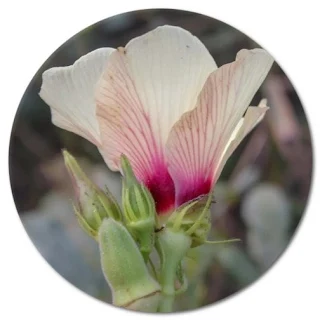Information about the Abelmoschus (Okra) flower
Depending on climatic conditions, it can grow up to 2 meters. The root system is quite deep. The fruit is an elongated pyramid-shaped fruit with round, oval and green seeds. It is resistant to drought. Leaves are 10 to 20 cm long, broadly elliptic with 5 to 7 lobes. Flowers 4 to 8 cm in diameter. There are 5 white to yellow petals, each petal has a red or purple spot on the underside. The fruit capsule is 18 cm long and contains many seeds. Flowers are beautiful. It prefers permeable, rich soils and sunny areas. Seeds germinate in 1 week at 35 degrees Celsius.
What is Abelmoschus in English? "Abelmoschus" is the scientific or botanical name for a genus of flowering plants. In English, the common name for some species within this genus is "musk mallow." One well-known species within the Abelmoschus genus is Abelmoschus moschatus, commonly referred to as musk mallow or musk okra. The name "Abelmoschus" is derived from the Arabic words "abel" and "moschus," which mean "source of musk." This is in reference to the musky fragrance of the plants, particularly the seeds.
The Abelmoschus flower is associated with plants in the genus Abelmoschus, which is part of the larger mallow family, Malvaceae. These plants are known for their attractive flowers and are cultivated for various purposes, including ornamental, culinary, and medicinal uses. Here are some key points about the Abelmoschus flower:
Genus and Species:
- The genus Abelmoschus includes several species, and one of the well-known species is Abelmoschus moschatus.
- Abelmoschus moschatus is commonly known as musk mallow or musk okra.
Appearance:
- The Abelmoschus flower is typically large, showy, and comes in various colors, including yellow, white, and pink.
- The flowers often have a distinct hibiscus-like appearance, as the plants are related to hibiscus.
Fragrance:
- One of the notable features of Abelmoschus moschatus is its musky fragrance. The flowers are known for their sweet, musky scent, which is where the plant gets its common name "musk mallow."
Culinary Uses:
- In some cultures, the flowers of Abelmoschus plants are used in culinary applications. The flowers can be cooked or used as an ingredient in various dishes.
Medicinal Uses:
- In traditional medicine, certain parts of Abelmoschus plants, including the flowers, are believed to have medicinal properties.
- Extracts from Abelmoschus moschatus are used in traditional medicine in some regions for various purposes, including treating skin disorders and respiratory issues.
Ornamental Purposes:
- Abelmoschus plants are cultivated for their attractive flowers and are often grown in gardens or landscapes for ornamental purposes.
Habitat and Cultivation:
- Abelmoschus plants are found in various regions and are often grown in warm climates. They require well-drained soil and plenty of sunlight.
Other Names:
- Besides musk mallow, Abelmoschus moschatus is known by various other names, including ambrette, musk okra, and ornamental okra.
It's important to note that the specific characteristics and uses of Abelmoschus flowers can vary depending on the species and cultural practices in different regions. If you have a particular species in mind, additional details may be needed to provide more specific information.
What is the common name for Abelmoschus?
What is Abelmoschus used for?
Abelmoschus, particularly the species Abelmoschus moschatus, has various uses across different cultures. Here are some common uses:
Medicinal Purposes:
- In traditional medicine, various parts of Abelmoschus plants, including the flowers, leaves, and seeds, are believed to have medicinal properties.
- Extracts from Abelmoschus moschatus are used in traditional medicine for treating a range of conditions, including skin disorders, respiratory issues, and digestive problems.
Fragrance and Perfumery:
- The seeds of Abelmoschus moschatus are a source of musk fragrance. The plant is sometimes called "musk mallow" because of the musky scent emitted by its seeds.
- The musk fragrance is used in the production of perfumes and other aromatic products.
Culinary Uses:
- In some cultures, the flowers and young leaves of Abelmoschus plants are used as a culinary ingredient.
- The mucilaginous properties of certain parts of the plant, like the okra-like seed pods, are valued for thickening soups and stews.
Ornamental Purposes:
- Abelmoschus plants are cultivated for their attractive and showy flowers, making them popular in gardens and landscapes for ornamental purposes.
Oil Extraction:
- The seeds of Abelmoschus moschatus can be pressed to extract an oil. This oil is sometimes used for various purposes, including in cooking and as a base oil in traditional medicine.
Traditional Practices:
- In some regions, Abelmoschus plants are used in cultural and traditional practices, including rituals and ceremonies.
Fiber Production:
- Some species within the Abelmoschus genus, such as Abelmoschus esculentus (okra), are cultivated for the production of fiber.
It's important to note that the uses of Abelmoschus can vary across different regions and cultures, and the specific species of Abelmoschus may have different applications. Additionally, while there are traditional uses, scientific research is ongoing to explore the potential pharmacological and therapeutic properties of Abelmoschus plants.
What does Abelmoschus mean in Latin?
The word "Abelmoschus" is derived from the Arabic words "abel" and "moschus," which mean "source of musk." In Latin, the term retains the same meaning. The genus name "Abelmoschus" is used to describe a group of flowering plants, and it refers to the musky fragrance associated with the seeds of these plants, particularly in the species Abelmoschus moschatus. The musky scent is often used in perfumery, and the name reflects this characteristic of the plant.
When to plant Abelmoschus? When it blooms
The planting time for Abelmoschus can depend on the specific species and the local climate conditions. However, in general, Abelmoschus plants, such as Abelmoschus moschatus (musk mallow), are typically warm-season annuals that thrive in tropical and subtropical climates. Here are some general guidelines:
Planting Time:
- Abelmoschus is usually planted in the spring or early summer when the soil has warmed up, and the risk of frost has passed.
- In tropical regions, where frost is not a concern, you can plant Abelmoschus throughout the year, provided there is enough warmth and sunlight.
Soil and Sunlight:
- Plant Abelmoschus in well-drained soil that receives full sunlight.
- These plants prefer warm temperatures and do well in locations with plenty of sunlight.
Blooming Time:
- Abelmoschus plants, especially Abelmoschus moschatus, typically bloom during the warm months of summer and into early fall.
- The exact timing of blooming can vary based on factors such as climate, local growing conditions, and the specific variety of Abelmoschus.
Growing Conditions:
- Provide adequate water to keep the soil consistently moist but not waterlogged.
- Mulching around the plants can help retain moisture and suppress weeds.
Container Planting:
- Abelmoschus can also be grown in containers, making it suitable for patio gardens or areas with limited space. Ensure the containers have good drainage.
It's essential to check the specific recommendations for the particular species or variety of Abelmoschus you are planting, as there can be some variation in their growth requirements. Additionally, local gardening guides and agricultural extension offices can provide information tailored to your specific region and climate.





Comments
Post a Comment